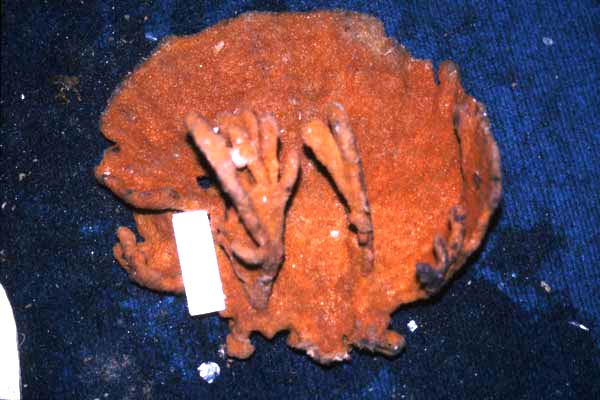| Gross morphology is variable, ranging from low growing foliose bushy subspherical sponges with clathrous digits, to flabelliform or digitate fans with a long basal stalk and flattened or irregularly cylindrical branches. |
| Bright red to orange-red alive. |
| Oscules are congregated into special pore areas on the sides of branches or on the membranous dermis between surface conules, and flabellate specimens may have Phakellia-like pores grouped into stellate pore-areas. |
| Texture is firm, barely compressible but flexible. |
| Surface is irregularly microconulose with close-set subdermal ridges and striations, and a woody basal stalk. |
| Fibre characteristics, skeletal architecture and the distribution of megascleres and microscleres are identical to C. (T.) lendenfeldi. |
| The ectosomal skeleton varies from the Clathria condition, which is simply membranous between microconules and with very few tangentially placed spicules on the tops of conules, to the Thalysias condition with distinct erect or paratangential brushes of smaller auxiliary megascleres. |
| Choanosomal principal styles are thick, slightly curved, fusiform, with rounded or subtylote, smooth or microspined bases (in equal proportions). Length 187.1-(250.5)-388.1 ï¾µm, width 5.1-(15.1)-36.2 ï¾µm. Subectosomal auxiliary subtylostyles are long, straight, fusiform or with rounded tips, usually with subtylote microspined bases and points. Length 156.1-(287.8)-439.1 ï¾µm, width 1.8-(5.7)-13.6 ï¾µm. Ectosomal auxiliary subtylostyles are similar. Length 83.6-(136.8)-193.2 ï¾µm, width 1.1-(3.8)-8.6 ï¾µm. Acanthostyles are long, thick, with large spines on the base and apex and a large unspined |
| Palmate isochelae are small and unmodified. Length 6.1-(10.4)-15.9 ï¾µm. Toxas vary from short and thin to long and very thick, with large rounded central crvature and reflexed arms. Length 27.1-(108.9)-390.2 ï¾µm, width 0.6-(2.3)-5.1 ï¾µm. |

